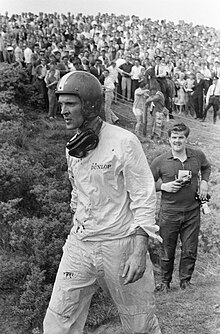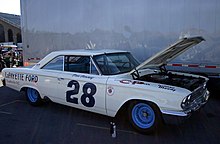Dan Gurney
Daniel Sexton Gurney (April 13, 1931 – January 14, 2018) was an American racing driver, engineer and motorsport executive, who competed in Formula One from 1959 to 1970.
Widely regarded as one of the most influential figures in the history of motorsport,[a] Gurney won four Formula One Grands Prix across 11 seasons.
After serving in the United States Army as an artillery mechanic during the Korean War, Gurney entered the 1957 Riverside Grand Prix, beating numerous established drivers including Phil Hill and attracting the attention of Luigi Chinetti, who organised his professional debut at the 24 Hours of Le Mans in 1958 with NART.
His performance at Le Mans prompted Ferrari to sign Gurney for the 1959 season, making his Formula One debut at the French Grand Prix after winning the 12 Hours of Sebring with the team two months prior.
Gurney moved to Brabham in 1963 as their first-ever driver, taking multiple wins in three seasons at the team, including another fourth-placed championship finish in 1965.
[b] Despite struggling for reliability with the Len Terry-designed Eagle T1, Gurney took his final victory at the 1967 Belgian Grand Prix, before leaving the sport at the end of 1968.
In aerodynamics, he is remembered for his invention of the Gurney flap, and became the first Formula One driver to wear a full-face helmet at the 1968 German Grand Prix.
[12] This ill-handling brute of a car was very fast, but even top drivers like Carroll Shelby and Ken Miles had found it difficult to handle.
He finished second in the inaugural Riverside Grand Prix (behind Shelby), beating established stars like Masten Gregory, Walt Hansgen and Phil Hill.
This attracted the attention of famed Ferrari North American importer Luigi Chinetti, who arranged for a factory ride for the young driver at Le Mans in 1958.
At the Dutch Grand Prix, at Zandvoort, a brake system failure on the BRM caused the most serious accident of his career, breaking his arm, killing a young spectator and instilling in him a longstanding distrust of engineers.
The accident also caused him to make a change in his driving style that later paid dividends: his tendency to use his brakes more sparingly than his rivals meant that they lasted longer, especially in endurance races.
[18] During the 1.5-litre era of Formula 1, Gurney's head and shoulders extended high into the windstream compared to his shorter competitors, giving him (he felt) an aerodynamic disadvantage in the tiny, underpowered cars.
Because Gurney's first love was road racing, especially in Europe, he wanted to win the Formula One World Championship while driving an American Grand Prix 'Eagle'.
[citation needed] Partnered with British engine maker Weslake, the Formula One effort was called "Anglo American Racers."
The next season the team failed to finish any of the first three races, but on June 18, 1967, Gurney took a historic victory in the Belgian Grand Prix.
On rare occasions, as when his car fell behind with minor mechanical troubles and he felt he had nothing to lose, he would abandon his classic technique and adopt a more aggressive (and riskier) style.
This circumstance produced what many observers consider the finest driving performance of his career, when a punctured tire put him nearly two laps down halfway through the 1967 Rex Mays 300 Indycar race at Riverside, California.
He produced an inspired effort, made up the deficit and won the race with a dramatic last-lap pass of runner-up Bobby Unser.
Gurney is credited with numerous appearances in NASCAR Grand American stockcars, a pony car division that existed between 1968 and 1971, but these results came in races co-sanctioned with SCCA's Trans-Am, where Dan competed regularly for Mercury, and later Plymouth.
Gurney agreed to drive a second Rod Osterlund Chevrolet for one NASCAR race as teammate to 1979 rookie of the year Dale Earnhardt.
In a Chevy MonteCarlo painted white with blue and carrying his famed number 48, Gurney qualified seventh and easily ran with the leaders.
Displaying his usual fluid style, Gurney raced up to second place, and was running third when the input shaft in the transmission let go, something Dan later said he had never seen happen before or since.
Gurney was recruited by Carroll Shelby, who was mounting a Ford-powered challenge to Ferrari's dominance of the FIA 2+ liter GT class in the World Championship of Makes for the 1964 season.
[29] Ford's hopes for edging Ferrari for the Manufacturers' title at the 1000 km Monza season finale were dashed when the event was cancelled.
After problems highlighted by the fatal accident of Ken Miles in testing the Mark III "J Car," another iteration was designed but it would not be built in time for the season opener at the 24 Hours of Daytona.
[34] After that demonstration the Mk IVs were held in preparation for Le Mans, with Ford's hopes for a repeat championship resting on the GT40s and GT40-derived Mirages campaigned by other teams in the intervening races.
The static about Foyt was more stereotype than reality, as he had shown his road course mettle with a second-place showing at the grueling 12 Hours of Sebring in a Mk II earlier that year.
Gurney and Yates made the run in 35 hours and 54 minutes in a stock 1971 Sunoco-blue Ferrari 365GTB/4 Daytona coupe capable of 175 mph (282 km/h).
All American Racers announced the news on its website: "With one last smile on his handsome face, Dan drove off into the unknown just before noon today, January 14, 2018.






